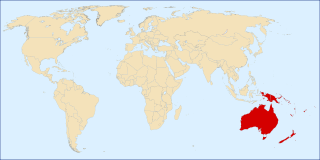
Oceania is a geographical region comprising Australasia, Melanesia, Micronesia, and Polynesia. Spanning the Eastern and Western Hemispheres, at the centre of the water hemisphere, Oceania is estimated to have a land area of about 9,000,000 square kilometres (3,500,000 sq mi) and a population of around 44.4 million as of 2022. When compared to the other continents, Oceania is the smallest in land area and the second-least populated after Antarctica.

Melanesia is a subregion of Oceania in the southwestern Pacific Ocean. It extends from New Guinea in the west to the Fiji Islands in the east, and includes the Arafura Sea.

Pacific Islanders, Pasifika, Pasefika, Pacificans or rarely Pacificers are the peoples of the Pacific Islands. As an ethnic/racial term, it is used to describe the original peoples—inhabitants and diasporas—of any of the three major subregions of Oceania.

This is a list of hospitals in Oceania for each sovereign state, associated states of New Zealand, and dependencies, and territories. Links to lists of hospitals in countries are used when there are more than a few hospitals in the country. Oceania has an area of 8,525,989 km2 and population of 41,570,842 (2018). The World Health Organization surveys of healthcare in smaller countries are used to identify hospitals in smaller countries.

The Fiji men's national football team is Fiji's national men's team and is controlled by the governing body of football in Fiji, the Fiji Football Association. The team plays most of their home games at the HFC Bank Stadium in Suva.

Melanesians are the predominant and indigenous inhabitants of Melanesia, in an area stretching from New Guinea to the Fiji Islands. Most speak one of the many languages of the Austronesian language family or one of the many unrelated families of Papuan languages. There are several creoles of the region, such as Tok Pisin, Hiri Motu, Solomon Islands Pijin, Bislama, and Papuan Malay.

The Papua New Guinea national soccer team is the men's national soccer team of Papua New Guinea and is controlled by the Papua New Guinea Football Association. Its nickname is the Kapuls, which is Tok Pisin for Cuscus.

The approximately 450 Oceanic languages are a branch of the Austronesian languages. The area occupied by speakers of these languages includes Polynesia, as well as much of Melanesia and Micronesia. Though covering a vast area, Oceanic languages are spoken by only two million people. The largest individual Oceanic languages are Eastern Fijian with over 600,000 speakers, and Samoan with an estimated 400,000 speakers. The Gilbertese (Kiribati), Tongan, Tahitian, Māori and Tolai languages each have over 100,000 speakers. The common ancestor which is reconstructed for this group of languages is called Proto-Oceanic.

Melanesian mythology refers to the folklore, myths, and religions of Melanesia, a region in Southwest Oceania that encompasses the archipelagos of New Guinea, the Torres Strait Islands, Solomon Islands, Vanuatu, New Caledonia and Fiji. The various mythologies consist primarily of the traditions of oral literature in the different populations of Melanesia. More recent aspects include the cargo cults born in the 20th century during the Pacific War.
The Melanesia Cup 2000 was the seventh and the last Melanesia-wide tournament ever held. It took place in Fiji and five teams participated: Fiji, Solomon Islands, New Caledonia, Papua New Guinea and Vanuatu and served for the third time as an Oceania Nations Cup qualifier.

The Central Indo-Pacific is a biogeographic region of Earth's seas, comprising the tropical waters of the western Pacific Ocean, the eastern Indian Ocean, and the connecting seas.
This is a list of lists of cities in Oceania.

The following outline is provided as an overview and topical guide to Oceania.
The Oceania Table Tennis Federation (OTTF) is a table tennis organization founded on 1 June 1977, recognized by International Table Tennis Federation (ITTF) as its continental federation in Oceania. Discussions began at the Commonwealth Table Tennis Championships held in Melbourne, 1975. Seven foundation members were New Zealand, Australia, Guam, Papua New Guinea, Fiji, New Caledonia and Tahiti.

Oceania is a region centered on the islands of the tropical Pacific Ocean. Conceptions of what constitutes Oceania vary, with it being defined in various ways, often geopolitically or geographically. In the geopolitical conception used by the United Nations, International Olympic Committee, and many atlases, the Oceanic region includes Australia and the nations of the Pacific from Papua New Guinea east, but not the Malay Archipelago or Indonesian New Guinea. The term is sometimes used more specifically to denote Australasia as a geographic continent, or biogeographically as a synonym for either the Australasian realm or the Oceanian realm.
Athletics competitions at the 2007 Pacific Games were held at the Apia Park in Apia, Samoa, between September 3–8, 2007. A total of 45 events were contested, 23 by men and 22 by women. This year 6 games records were set.
The 2017 FIBA Melanesian Basketball Cup was an international basketball tournament contested by national teams of the newly formed Melanesia sub-zone of FIBA Oceania. The inaugural edition of the tournament were hosted by Papua New Guinea from 27 to 30 September 2017. Matches were played at the Taurama Aquatic and Indoor Centre. It was officially launched on 19 May 2017.
List of events that happened during 2021 in Oceania.













